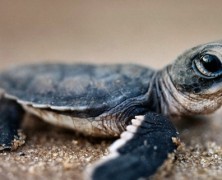A unique project in coastal Florida uses LED lighting to help young hatchlings avoid danger and find their way to the ocean. Led by the Sea Turtle Conservancy, the installation addresses a long-standing problem that has grown steadily worse over the past 30 years. This latest project joins human-centric and grow lights on an expanding list of fascinating biologic applications of LED lighting. As first reported in Scientific American, the installation specifically helps new sea turtle hatchlings find a direct path to ocean safety. Hatchlings typically emerge from their eggs in late afternoon or early evening, crawling up through sand from about 50 centimeters below the beach surface. They instinctively head for the soft lights on the ocean horizon, guided by moon and star reflections on the water. But this natural light is now eclipsed by the hotels, homes and restaurants that dominate today’s beachfront zones. The young turtles quickly become disoriented, often heading in the wrong direction. It’s a fatal mistake, as they can easily die of dehydration, get run over by cars or be eaten by inland predators. The situation is a significant threat to the survival of at least three endangered sea turtle species. Florida is home to 90 percent of sea turtle nesting in the U.S., and it is estimated that tens of thousands of hatchlings are lost each year. The Sea Turtle Conservancy (STC) has thus targeted this coastal area for a series of lighting retrofits aimed at reducing disorientation. So far, numbers prove that this LED lighting installation is helping save baby sea turtles. The retrofit has other benefits as well: LED lighting uses a fraction of the energy consumed by other lighting technologies, and lasts for several years with little to no maintenance costs. Further, residents and business...






